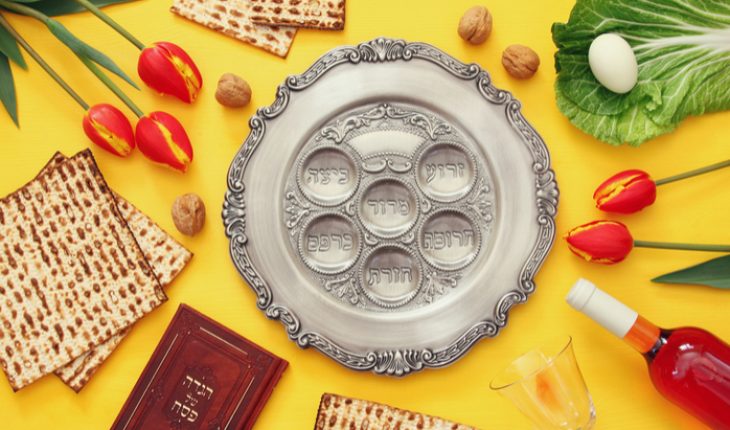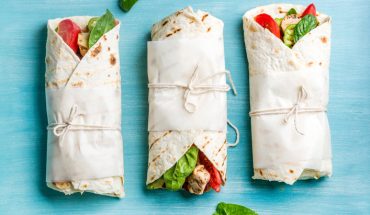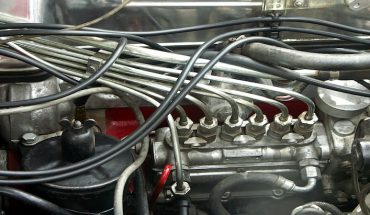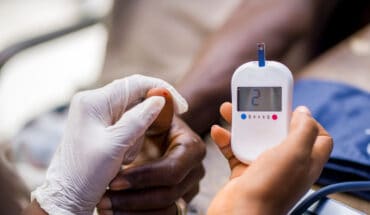Roughly coinciding with Easter, Jewish Passover (which this year falls between 30th March to 7th April), commemorates the Israelites exodus from slavery in Egypt. To celebrate this momentous event, each spring Jewish people from around the world remember the story of their lucky escape at a celebratory meal called the Seder (which means ‘order’ in Hebrew), which provides a richly symbolic and sensory experience. Passover begins at sundown this Friday, marking the first of eight days and nights. The heart of Passover is the Passover Dinner (Seder) the ritual meal that usually takes place in the home on the first night and Seder plate, which traditionally includes five, or six different Passover foods, each symbolising a different aspect of the flight from Egypt and redemption from slavery.
The heart of Passover is the Passover Dinner (Seder) the ritual meal that usually takes place in the home on the first night and Seder plate, which traditionally includes five, or six different Passover foods, each symbolising a different aspect of the flight from Egypt and redemption from slavery.
During this feast people taste these foods to physically re-enact the Exodus story – so that each person feels as if he, or she has personally fled from Egypt. Here’s a look at the symbolism and many health benefits of seven central Passover foods.
Eggs
Unlike chocolate Easter eggs, during the Passover feast eggs are traditionally served hard-boiled and mixed with salt water as an appetizer. Eggs are rich in muscle building proteins and chock full of vitamins A & D, choline that helps preserve memory, as well as lutein and zeaxanthin, important for eyesight. Research from the Mayo Clinic found that although eggs are high in cholesterol good, the effect of this on blood cholesterol is minimal when compared with trans fats and saturated fats. Most people can eat a couple of eggs a week without having to worry about heart disease and studies have shown that they may help prevent some types of strokes. However people suffering from diabetes should be careful about egg consumption owing to a higher risk of heart disease.
Matzah
Also spelled matzoh and matza, matzah is the unleavened bread eaten during the eight days of Passover instead of bread. Also named ‘the bread of affliction,’ Lechem Oni in Hebrew, matzah symbolizes the Jewish people’s speedy flight from the Egyptians when they did not have enough time to bake fresh bread for their journey. Instead they quickly made unleavened bread and baked it in the sun and zipped away to freedom before the Pharaoh could change his mind. Instead of bread, Jews enjoy sandwiches made on matzah during Passover. Traditionally made in a chicken stock Matzah ball soup and containing carrots, onions and celery is packed with nutritious nutrients including vitamin B6, niacin, riboflavin and potassium. Cakes made from matzah meal can also be enjoyed.
Wine
It is traditional to drink four glasses of red wine during Passover during the telling of the Exodus story to celebrate freedom from slavery and oppression. Research has shown that traces of the antioxidant resveratrol, which helps prevent heart disease, is found in many red wines. Moderate wine drinking also helps bring people together and creates a congenial mood.
Horseradish
In Passover bitter herbs symbolize the tears shed by the Jewish people during their enslavement in Egypt and their suffering. Horseradish makes an appearance on many Passover tables to represent bitter herbs and can be served to spice up gefilte fish. Packing a punch, despite its weedy appearance horseradish is low in calories and contains potassium, vitamin C, calcium, phosphorus and magnesium as well as the plant chemical glucosinolate which is thought to have anti-cancer properties.
Gefilte Fish
White fish, with a delicate flavour is traditionally used to make gefilte fish, (Yiddish for stuffed fish). This is ground and combined with eggs, spices and carrots to make fish cakes that can be fried or poached. As well as being delicious, gefilte fish is full of nutrients, including energy-giving protein and B vitamins, potassium, zinc and selenium.
Shank Bone
Back in the day of Ancient Israel and the Holy Temple, it was customary for the Israelites to offer a sacrifice by slaughtering a lamb. Although around 2,000 years have passed this tradition symbolically lives on in the shank bone, or z’roa in Hebrew, on the Seder plate. Unlike the other foods at the Seder dinner the shank bone is purely symbolic and a visual reminder of the long journey of Exodus and not consumed.
Charoset (mix of fruits, nuts, honey, or sweet wine)
During the Passover holiday many other healthy foods are traditionally eaten including nuts, almonds, apples, avocado and almond flour, rich in fatty acids essential for the absorption of fat soluble vitamins and helping healthy skin and hair. Apples and walnuts on the seder plate, sometimes accompanied by red wine symbolize bricks and mortar used by the long-suffering Jewish slaves in Egypt and the promise of a new life free of bondage when the Pharaoh let them go. These foods have anti-inflammatory properties and help to reduce cholesterol and protect against heart disease. Recently some gay communities have adopted an orange on the seder plate, symbolizing sympathy for marginalized groups.
For people wanting to know more about Jewish Passover, the Jewish Museum, London has a permanent display devoted to Passover on the first floor.
Jewish Museum London, Raymond Burton House, 129-131 Albert Street, London NW1 7NB (nearest underground Camden Town)
Open every day 10am – 5pm (early closure Friday at 2pm), last entrance is 30 minutes before closing
Open on Bank Holidays, but closed on 10 and 11 September 2018 for Jewish New Year, early close 18 September, closed 19 September, closed 25, 26 December and 1st January
- People’s Choice Victory for Down’s Syndrome Scotland Garden at Chelsea 2025 - 28th May 2025
- Cadogan: A Chelsea Family By Tamsin Perrett - 3rd May 2025
- Dream Worlds a new exhibition in Cambridge - 14th December 2024







